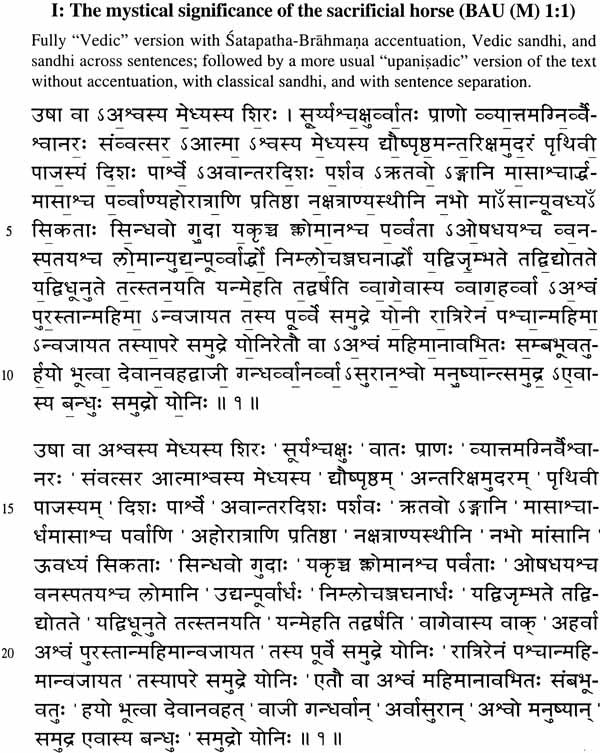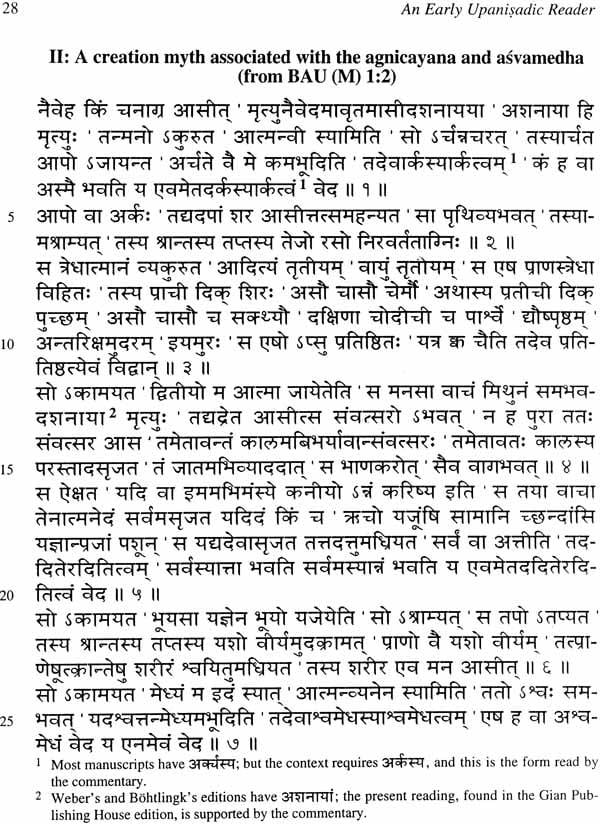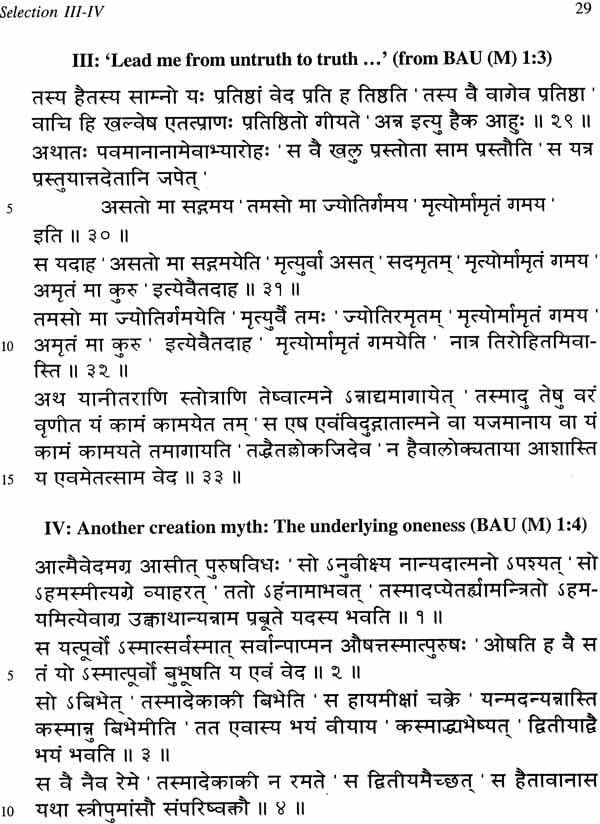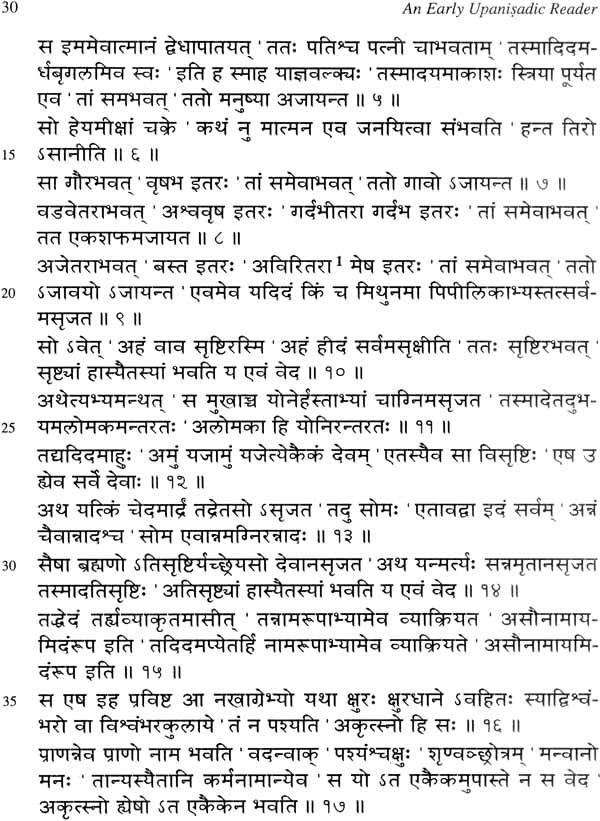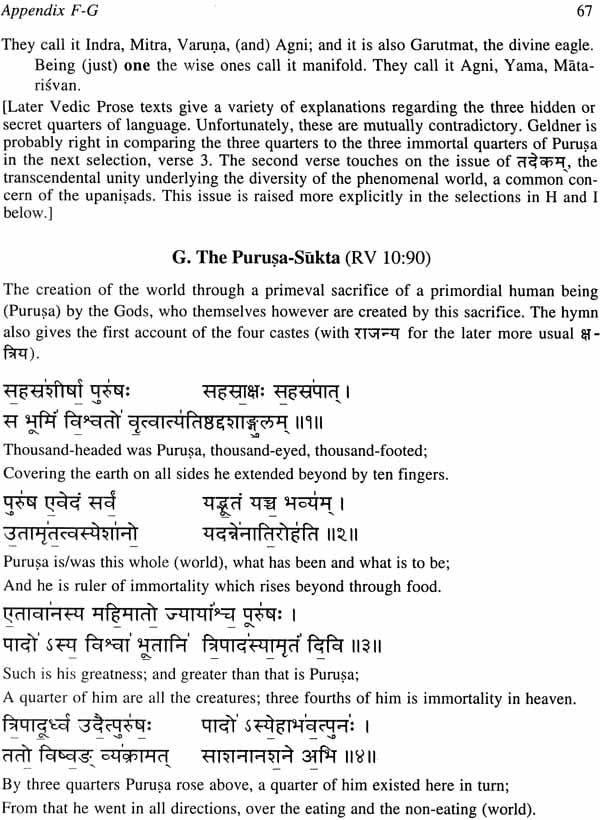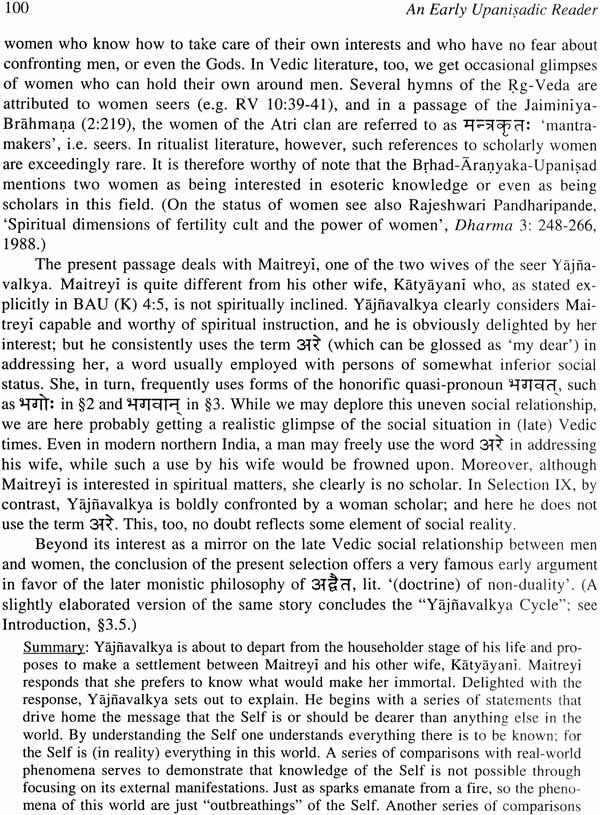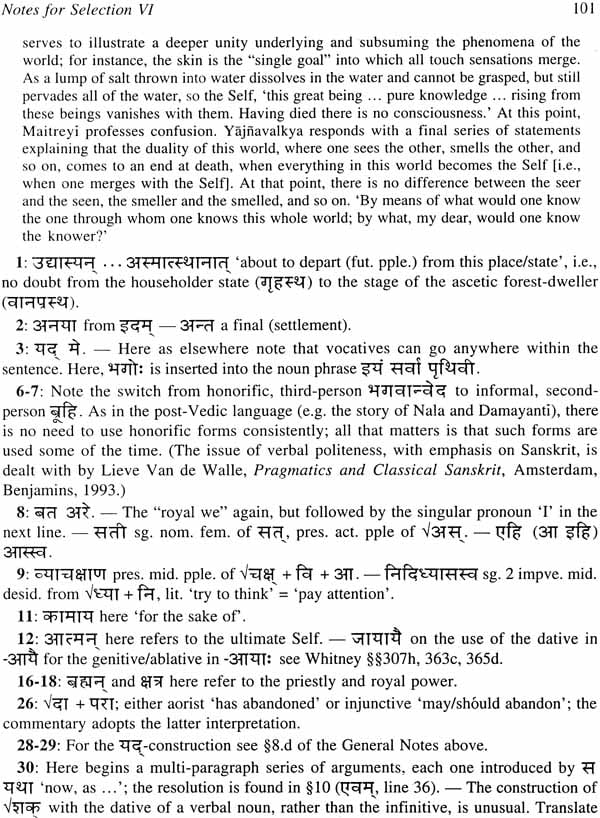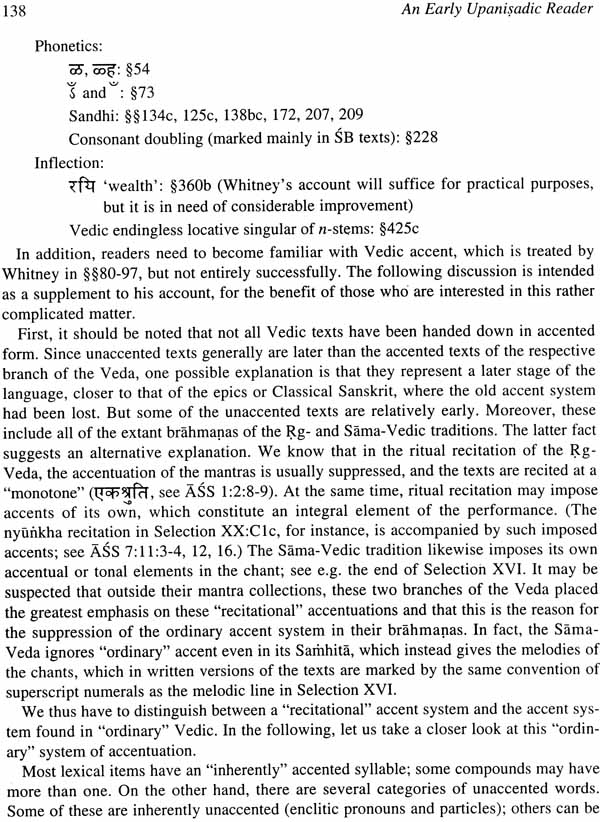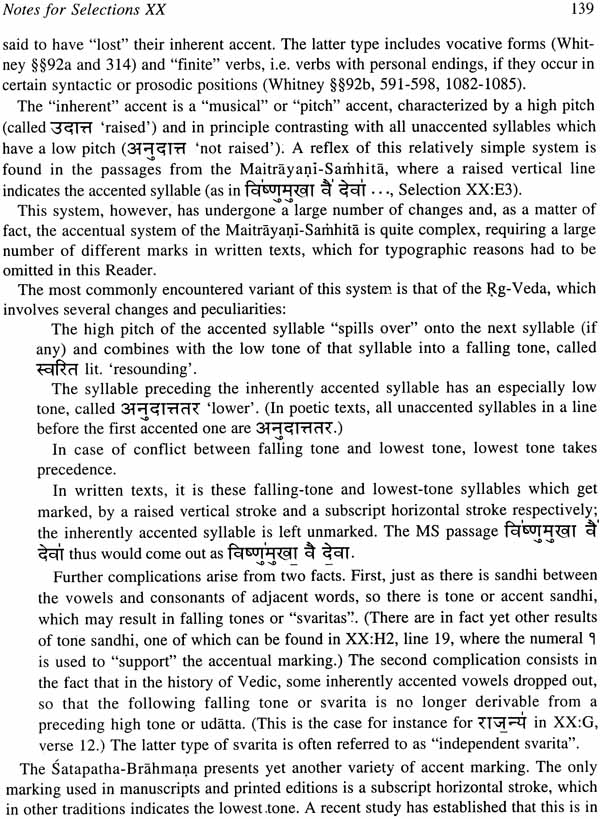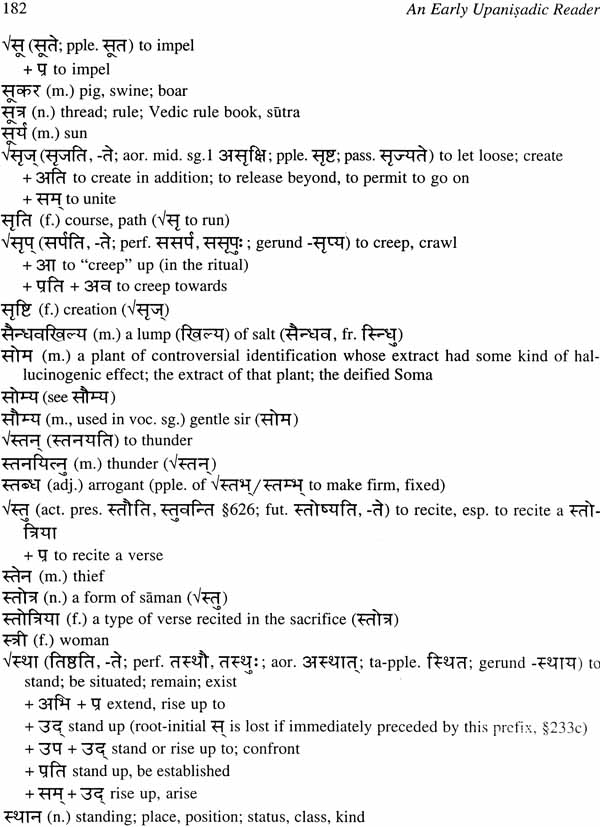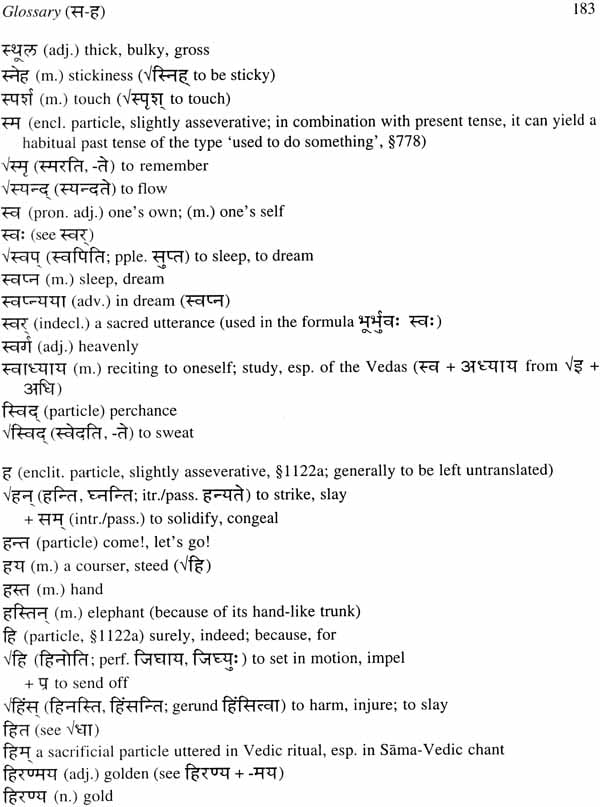
An Early Upanisadic (Upanishadic) Reader
Book Specification
| Item Code: | IDJ360 |
| Author: | Hans Henrich Hock |
| Publisher: | Motilal Banarsidass Publishers Pvt. Ltd. |
| Language: | Sanskrit Text with English Translation |
| Edition: | 2007 |
| ISBN: | 9788120832145 |
| Pages: | 203 |
| Cover: | Hardcover |
| Other Details | 10.8" X 8.4" |
| Weight | 620 gm |
Book Description
Preface
The great upanisads of the late Vedic period take a position in the literary and philosophical tradition of Sanskrit that can be characterized as Janus-faced in western terms or in India terms, as a light on the threshold which illuminates both what is behind and in front. From one perspective the early upanisads constitute the end- according to some, the culmination- of the long and prolific Vedic period. From a different point of view they are the starting point for a philosophical tradition that pervades all of post-Vedic India, whether orthodox (Hindu) or heterodox (Buddhist and Jaina).
It is here that the question of the transcendental unity behind the great diversity of the phenomenal world is systematically addressed. The issue had, of course, been mooted in the earlier Vedic tradition, especially under the heading 'that one (entity)' from which everything has evolved. But it is in the last Vedic upanisads that the issue is met head-on, with various competing characterizations of as Brahman, Atman, and even more profoundly as beyond any positive definition, describable only negatively as neti neti and the like.
It is here, too, that the important concepts of karman and reincarnation are first formulated, concepts that are foundational to all post-Vedic Indian religions. Again, there were earlier Vedic antecedents, especially in the later portions of the Brahmans. Most notable among these is the concept of repeated death in "yonder world" which deprives the deceased of immortality. But again, it is only in the late Vedic upanisad that coherent theories of 'rebirth', based on the nature of one's are beginning to be developed. (The term used by the early upanisads actually in 'returning'.)
Just as the early upanisads of the late Vedic era are a point of transition in Indian religious thinking, so they also constitute a transitional period in terms of their grammar and language use. Features of Vedic grammar and diction coexist with rhetorical strategies and methods of argumentation that characterize post-Vedic sastric texts. The early upanisads, therefore, offer an excellent entry point to the Vedic language for students familiar with Classical Sanskrit.
It is for these reasons that some ten years ago I began preparing this Early Upanisadic Reader, for student who had completed the better part of two years of Classical Sanskrit instruction at the Universtiy of Illinois.
I have benefited from my students feedback, even though- or because- in the early years it often expressed itself as deep frustration with trying to make sense of the texts, their "alien" grammar and diction, and their "arcane" subject matter. I have also profited form feedback by my teaching associates, Yasuko Suzuki and Sarah Tsiang. I am especially grateful to Sarah Tsiang who made copious suggestions for improving the explanatory Notes and the Glossary and who painstakingly went over the entire text in search of misprints, ambiguities, and other infelicities. In fact, the idea of a self-contained Glossary came from Sarh Tsiang, and she also contributed the large majority of the entries.
If the present form of the Reader is able to accomplish its goal of providing a helpful introduction to the early upanisads and to the Vedic language in general, the credit must go to my students, to Yasuko Suzuki and especially to Sarah Tsiang. I have to take the responsibility for any problems that remain.
Finally, let me express my deepest gratitude to my wife, Zarina and to our son, Heinrich Sharad, for their love and support.
1. The Purpose of this Reader
Since its publication in 1884, Lanman's Sanskrit Reader' has been the most widely used English-language introduction to original Sanskrit texts. What has been especially useful for beginning students are the copious notes and the glossary, as well as helpful references to Whitney's Sanskrit Grammar. Even so, students and teachers alike have had problems with some aspects of Lanman's Reader, including the fact that it refers to the first edition of Whitney's Grammar, not the second one, which appeared in 1889/ five years after Lanman's Reader. More important, many students today do not have the background in classical Greek and Latin that could be taken for granted in Lanman's and Whitney's times; the work of Sanskrit scholars since the 1880s has in many cases produced better editions of the texts that Lanman incorporated in his Reader; and even more significant, this more recent work has had a profound impact on our understanding of the texts. A new, updated edition therefore would be highly desirable. The present Reader has a more modest goal - to add to Lanman's Vedic selections and, in so doing, to offer beginning Sanskrit students an avenue to the Vedic language which, I hope, they will find more accessible.
Lanman's Vedic selections come mainly from the Rg- Veda, with some additions from the Yajur- Veda, most of which are concerned with the Vedic ritual.' plus a few selections from the late Vedic Grhya-Sutras and from Yaskas Nirukta. The philological, Indo-Europeanist tendencies of the nineteenth century naturally favored Lanman's heavy emphasis on the Rg- Veda, the oldest layer of Vedic literature, because presumably it is closest to the Indo-European parent language; and the ritualist texts were included because they were considered the oldest Indo-European prose texts. The switch, however, from Lanman's epic and classical selections to the Rg- Veda is enormous - in time, language, and style. Even specialists find Vedic hymns notoriously difficult to interpret, because we do not have any direct access to the religious, cultural, and linguistic contexts in and for which they were composed. And as Lanman himself states, the Vedic Prose texts of the brahmanas and of the prose portions of the Black Yajur- Veda samhitas tend to be quite "arid". (Lanman's general characterization of the texts, however, is overly uncharitable.) Whatever the merits of offering such texts to beginning Sanskrit students may have been in Lanman's times, today his selections are less than apt to attract beginning students' interest in the Vedic language.
My experience has shown that a selection of upanisadic texts has a better chance of arousing students' interest in the enormously rich tradition of Vedic language and literature. Because of their relative lateness these texts are closer to the language that students are familiar with from Lanman's post-Vedic selections. They reflect a time of intense intellectual speculation and discussion, out of which grew not only the later forms of philosophical Hinduism but no doubt also Buddhism, Jainism, plus other religious and philosophical systems that have since died out. Their topics and discussions therefore are of keen interest to anyone interested in the religious and philosophical traditions of India, and especially to the ever-growing number of students who want to learn Sanskrit in order to study these traditions. Moreover, the upanisads tend to employ a more interesting rhetorical style than the often rather turgid presentation of earlier Vedic Prose; they provide a window on aspects of the social and cultural life of their time, including the status of women; they even offer glimpses of humor.
The texts in this Reader have been selected to present as wide and representative a picture of the literature as possible. Being a selection, of course, the Reader could not possibly include all the texts that those who use it (or I, for that matter) might have wanted to see included. Selections I - XIX are presented in the same fashion as Lanman's selections, as texts to be translated by the students, aided by a glossary and notes with references to Whitney's Grammar. In one respect, however, this reader departs from Lanman's practice. Rather than forcing students to simultaneously wrestle with the difficulties of the Vedic language and with the complexities of Vedic ritual and philosophy, I provide at the beginning of the notes to each selection a brief content summary or in some cases a rough translation, as a guide to understanding the selection's purport and line of argument.
The Reader is supplemented by an Appendix, Selection XX, which gives related texts, mainly from the earlier Vedic literature, but including one post- Vedic upanisadic text that may provide a glimpse of how the different strands of thinking found in the earlier texts could be integrated into a more comprehensive, structured system of thought. These ancillary readings are presented together with translations that attempt to make it possible for readers to work out the meanings of the texts for themselves. The translations do not make any claim to providing "the" meaning of the texts, and they have no pretensions to literary elegance.
2. The Earlier Vedic Background of Upanisadic Thought
In his commentary on a particularly difficult passage in the Chandogya-Upanisad (5: 18: 1), which had elicited a variety of different interpretations, the great medieval philosopher Sankaracarya states, 'that is like people blind from birth in visualizing an elephant'. This is the first occurrence of a reference that keeps recurring in attempts to discuss the early history of India, whether from the perspective of literature, of religion and philosophy, or of language and linguistics. Any attempt to establish a clear chronology of events for that period is fraught with difficulties. Partly these difficulties result from the well-known fact that the sense of historicity which characterizes modern western thinking is alien to traditional India (just as it is to much of traditional Europe). But they also result from other factors, such as the fact that the text collections that have come down to us were composed over extended periods, during which different strands of thinking could be borrowed back and forth. The following attempt to locate the upanisads within the Vedic tradition, therefore, must be taken with a considerable dose of salt. Moreover, it should be kept in mind that the historical approach adopted here and in the western model of scholarship in general is not accepted by many modern Hindus, whether scholars or laypeople. For them, the Vedas are eternal, (i.e., not produced by humans), and therefore beyond history. The following discussion, therefore, is meaningless to those who hold this belief. At the same time, it is deeply meaningful to those who are interested in, and concerned with, the history of Indian traditions. The best that I can ask for is that adherents of these two views respect each others' perspectives, in spite of their differences.
European and European-inspired scholarship on the Indian I traditions began with scholars such as Sir William Jones, and in its early stages was often colored by ethno- centrism and worse. Lanman's discussion of the Vedic tradition (p. 352-358) very much reflects the preconceptions of western scholarship toward the end of the nineteenth century. He suggests two layers of Vedic literature: 1. An early period of hymnal poetry represented most prominently in the Rg- Veda and reflecting 'the life of a vigorous, active, and healthy people ... whose religion was a simple worship of the deified powers of nature.' 2. A later period in which 'the old Vedic religion was converted into an infinitely complex system of sacrifices and ceremonies. To this period belongs the belief in metempsychosis [reincarnation] ... The sultry air of Ganges-land has relaxed both the physical and the mental fibre of the Hindu, and he has become a Quietist.'
Even in Lanman's times scholars were beginning to realize that his interpretation is deficient on several counts - beyond the dubious value judgments. Most scholars would now agree that in principle we need to distinguish three periods: An early stage of hymnal poetry (mantras); a second stage of Vedic Prose concerned with explaining the use of the mantras, other verbal expressions, ritual implements, etc. in an increasingly complex ritual, and with establishing the mystical significance of the ritual; finally, the stage of the aranyakas and upanisads where mystical speculation turns to questions such as the transcendental unity underlying the phenomenal world, karman and reincarnation, and release from the cycle of reincarnations.' Some scholars further consider the final, upanisadic, stage a radical departure from the ritualist concerns of Vedic Prose, a veritable revolution in thinking.
This threefold layering of Vedic literature, however, is not directly reflected in the Vedic texts. The Rg- Veda contains numerous hymns dealing with the ritual and the priests officiating in it, the mystical significance of the ritual (see especially Selection XX:G of this Reader), and such issues as the origin of the world and the transcendental unity that underlies it (see the selections in XX:H and I). At least one hymn (XX:G) combines these two strands of thought by portraying the creation of the world as a primeval sacrifice of a primordial human being (Purusa) by the Gods - who themselves are created by this sacrifice.
| Preface | ix | |
| Introduction | 1 | |
| The Texts | 25 | |
| I: | The mystical significance of the sacrificial horse (B AU(M) 1:1) | 27 |
| II: | A creation myth associated with the agnicayana and asvamedha (from BAU (M) 1:2) | 28 |
| III: | Lead me from untruth (or non-being) to truth (or being) (from BAU (M) 1:3) | 29 |
| IV: | Another creation myth: The underlying oneness (BAU (M) 1:4) | 29 |
| V: | A Brahmin turns to a ksatriya as teacher and the parable of the sleeping man (from BAU (M) 2:1) | 33 |
| VI: | Yajnavalkya's and Maitreyi (BAU (M) 2:4) | 34 |
| VII: | Yajnavalkya's disputations at the assembly of King Janaka, 1: The cows and the hotr Asvala (BAU (M) 3:1) | 36 |
| VIII: | Yajnavalkya's disputation at the assembly of King Janaka, 2: Release from "re-death" (BAU (M) 3:3) | 38 |
| IX | Yajnavalkya's disputations at the assembly of King Janaka, 3: Vacaknavi Gargi challenges Yajnavalkya (BAU (M) 3:9) | 39 |
| X: | Yajnavalkya's disputations at the assembly of King Janaka, 4:Neti neti and Vidagdha Sakalya's head flies apart (from BAU (M) 3:9) | 40 |
| XI: | The beginning of Svetaketu's instruction in the transcendental unity of everything (from ChU 6:1-2) | 42 |
| XII: | The parables of the fig tree and of the salt, and (ChU 6:12 and 13) | 43 |
| XIII: | The significance of (ChU 1:1 with parallels from the Jaiminiya-Jaiminikya-Upanisad and Aitareya-Brahmans and from the Taittiriya-Aranyaka) | 44 |
| 1. Chandogya-Upanisad 1:1 | 44 | |
| 2. Jaiminiya-Brahmana 3:321-322 | 45 | |
| 3. Jaiminiya-Upanisad-Brahmana 1:1:1:1-5 and 3:4:5:6-7 | 45 | |
| 4. Aitareya-Brahmana 5:31:1-2 | 46 | |
| 5. Taittriya-Aranyaka 7:8:1 (Taittriya-Upanisad 1:8:1) | 46 | |
| XIV: | Mystical passages (BAU (M) 5:1 and 5:2) | 46 |
| XV: | The significance of the Gayatri, and mystical knowledge saves even the sinner (from BAU (M) 5:15) | 47 |
| XVI: | The dogs sacrifice: a satirical view of ritual (ChU 1:12) | 48 |
| XVII: | Reincarnation and karman, 1: Two closely related passages from BAU (M) 6:1 and ChU 5:3-10 | 48 |
| A: The Brhad-Aranyaka-Upanisad version | 48 | |
| B: Selections from the Chandogya-Upanisad version | 51 | |
| XVIII: | Reincarnation and karman, 2: Selections from KU 1 | 53 |
| XIX: | Identification with a personal God and (BAU (K) 5:15 = VS (K) 40:1:15-18) | 55 |
| XX: | Appendix: Related texts, mainly from earlier Vedic literature, with translations | 56 |
| A. Wedding mantras | 56 | |
| 1. Atharva-Veda 14:2:71 | 56 | |
| 2. Asvalayana Grhaya-Sutra 1:7 (Lanman p.99, line 2-5) | 56 | |
| 3. Jaiminiya-Upanisad-Brahmana 1:17:1) | 56 | |
| B. Ritual 'coupling' | 57 | |
| 1. An ordinary ritualist example (from SB (M) 1:1:1) | 58 | |
| 2. An interesting variant: The pairing of numbers (jaiminiya-Brahmana 2:291-292) | 58 | |
| C. More on om and other 'ritual particles' | 60 | |
| 1. Some early uses of om | 60 | |
| a. From Maitrayani-Samhita 4:9 and 1:4/4:1 | 60 | |
| b. From Aitareya-Brahmana 3:12:1-4 | 60 | |
| c. The "nyunkha", from Asvalayana-Srauta-Sutra 7:11:7 | 61 | |
| 2. Some other ritual particles | 61 | |
| 3. Mystical speculations on some ritual particles I: | 61 | |
| 4. Mystical speculations on some ritual particles II. | 63 | |
| D. The Gayatri or Savitri (from RV 3:62) | 63 | |
| E. 'Lead me from untruth to truth ' | 64 | |
| 1. Rg.-Veda 7:59:12 | 64 | |
| 2. Rg.-Veda 8:48:3 | 64 | |
| 3. A ritualist passage (Maitrayani-Samhita 1:4:2) | 65 | |
| 4. Another riutalist passage (Satapatha-Brahmana (M) 1:1:1:4) | 65 | |
| F. Rg-Vedic brahmodyas (from RV 1:164) | 65 | |
| G. The Purusa-Sukta (RV 10:90) | 67 | |
| H. Being and non-being | 69 | |
| 1. The nasadiya sukta (RV 10:129) | 69 | |
| 2. Asat:Sadjayat (from RV 10:72) | 71 | |
| 3. Asacha sacha(from RV 10:5) | 72 | |
| I. Hiranyagarm and ka = Prajapati(from RV 10:121) | 73 | |
| J. Ritualist passages connected with the agnicayana that "put it all together" (from Satapatha-Brahmana (M) 6 and 10) | 74 | |
| K. A late upanisadic passage that "Puts it all together" (from Subala Upanisad 1-3) | 78 | |
| Notes | 81 | |
| General Notes | 83 | |
| Notes for Selection I | 88 | |
| Notes for Selection II | 90 | |
| Notes for Selection III | 92 | |
| Notes for Selection IV | 92 | |
| Notes for Selection V | 97 | |
| Notes for Selection VI | 99 | |
| Notes for Selection VII | 103 | |
| Notes for Selection VIII | 105 | |
| Notes for Selection IX | 106 | |
| Notes for Selection X | 108 | |
| Notes for Selection XI | 113 | |
| Notes for Selection XII | 114 | |
| Notes for Selection XIII | 116 | |
| Notes for Selection XIV | 120 | |
| Notes for Selection XV | 121 | |
| Notes for Selection XVI | 122 | |
| Notes for Selection XVII:A | 123 | |
| Notes for Selection XVII:B | 128 | |
| Notes for Selection XVIII | 131 | |
| Notes for Selection XIX | 134 | |
| Notes for Selection XX | 137 | |
| Glossary | 141 | |
| References to Resources, Editions and Translations | 185 | |
| Indices | 193 | |
| General Index | 195 | |
| Language and Grammar Index | 201 |
